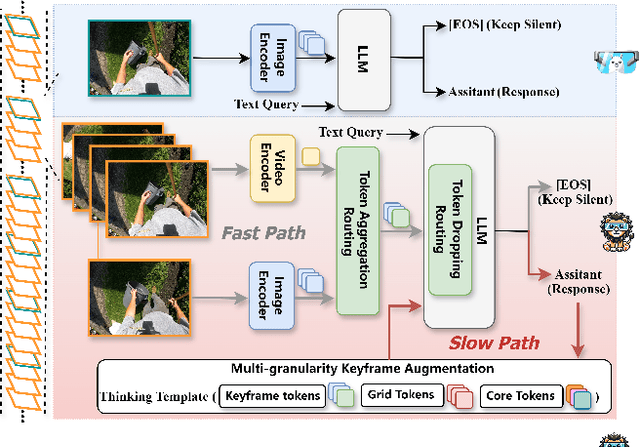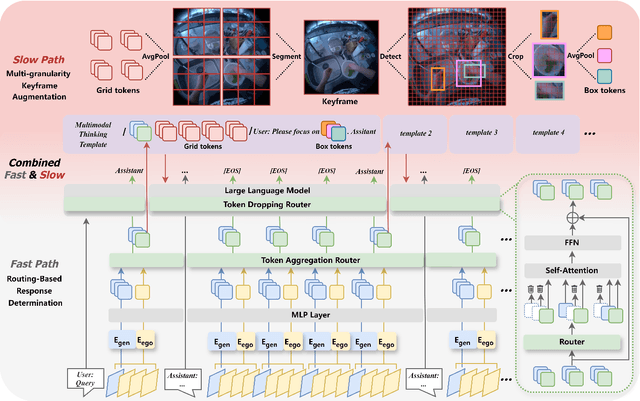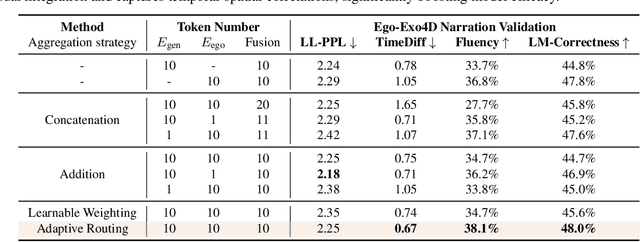Leyang Shen
LION-FS: Fast & Slow Video-Language Thinker as Online Video Assistant
Mar 05, 2025



Abstract:First-person video assistants are highly anticipated to enhance our daily lives through online video dialogue. However, existing online video assistants often sacrifice assistant efficacy for real-time efficiency by processing low-frame-rate videos with coarse-grained visual features.To overcome the trade-off between efficacy and efficiency, we propose "Fast & Slow Video-Language Thinker" as an onLIne videO assistaNt, LION-FS, achieving real-time, proactive, temporally accurate, and contextually precise responses. LION-FS adopts a two-stage optimization strategy: 1)Fast Path: Routing-Based Response Determination evaluates frame-by-frame whether an immediate response is necessary. To enhance response determination accuracy and handle higher frame-rate inputs efficiently, we employ Token Aggregation Routing to dynamically fuse spatiotemporal features without increasing token numbers, while utilizing Token Dropping Routing to eliminate redundant features. 2)Slow Path: Multi-granularity Keyframe Augmentation optimizes keyframes during response generation. To provide comprehensive and detailed responses beyond atomic actions constrained by training data, fine-grained spatial features and human-environment interaction features are extracted through multi-granular pooling. These features are further integrated into a meticulously designed multimodal Thinking Template to guide more precise response generation. Comprehensive evaluations on online video tasks demonstrate that LION-FS achieves state-of-the-art efficacy and efficiency.
MoME: Mixture of Multimodal Experts for Generalist Multimodal Large Language Models
Jul 17, 2024Abstract:Multimodal large language models (MLLMs) have demonstrated impressive capabilities across various vision-language tasks. However, a generalist MLLM typically underperforms compared with a specialist MLLM on most VL tasks, which can be attributed to task interference. In this paper, we propose a mixture of multimodal experts (MoME) to mitigate task interference and obtain a generalist MLLM. Our MoME is composed of two key components, a mixture of vision experts (MoVE) and a mixture of language experts (MoLE). MoVE can adaptively modulate the features transformed from various vision encoders, and has a strong compatibility in transformation architecture. MoLE incorporates sparsely gated experts into LLMs to achieve painless improvements with roughly unchanged inference costs. In response to task interference, our MoME specializes in both vision and language modality to adapt to task discrepancies. Extensive experiments show that MoME significantly improves the performance of generalist MLLMs across various VL tasks. The source code is released at https://github.com/JiuTian-VL/MoME
LION : Empowering Multimodal Large Language Model with Dual-Level Visual Knowledge
Nov 26, 2023



Abstract:Multimodal Large Language Models (MLLMs) have endowed LLMs with the ability to perceive and understand multi-modal signals. However, most of the existing MLLMs mainly adopt vision encoders pretrained on coarsely aligned image-text pairs, leading to insufficient extraction and reasoning of visual knowledge. To address this issue, we devise a dual-Level vIsual knOwledge eNhanced Multimodal Large Language Model (LION), which empowers the MLLM by injecting visual knowledge in two levels. 1) Progressive incorporation of fine-grained spatial-aware visual knowledge. We design a vision aggregator cooperated with region-level vision-language (VL) tasks to incorporate fine-grained spatial-aware visual knowledge into the MLLM. To alleviate the conflict between image-level and region-level VL tasks during incorporation, we devise a dedicated stage-wise instruction-tuning strategy with mixture-of-adapters. This progressive incorporation scheme contributes to the mutual promotion between these two kinds of VL tasks. 2) Soft prompting of high-level semantic visual evidence. We facilitate the MLLM with high-level semantic visual evidence by leveraging diverse image tags. To mitigate the potential influence caused by imperfect predicted tags, we propose a soft prompting method by embedding a learnable token into the tailored text instruction. Comprehensive experiments on several multi-modal benchmarks demonstrate the superiority of our model (e.g., improvement of 5% accuracy on VSR and 3% CIDEr on TextCaps over InstructBLIP, 5% accuracy on RefCOCOg over Kosmos-2).
 Add to Chrome
Add to Chrome Add to Firefox
Add to Firefox Add to Edge
Add to Edge